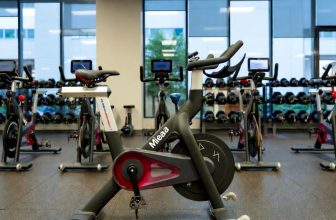Table of Contents
- How Far Should You Ride a Bike for Exercise?
- Factors Influencing Cycling Distance
- Fitness Goals
- Fitness Level
- Terrain and Intensity
- Recommended Distances by Goal
- Weight Loss
- Cardiovascular Fitness
- Endurance and Stamina
- Structuring Your Bike Ride
- Tips for Effective Cycling
- Common Mistakes to Avoid
- FAQs
- How far should a beginner cycle for exercise?
- Can I cycle every day for exercise?
- How many calories are burned cycling 10 miles?
- Is 5 miles enough for a cycling workout?
- Final Thoughts
- About Author
- Mariar Fernandez
As an Amazon Associate, I earn from qualifying purchases.
How Far Should You Ride a Bike for Exercise?
How Far Should You Ride a Bike for Exercise? The ideal distance to ride a bike for exercise depends on your goals and fitness level. Beginners should aim for 5-10 miles, 3-4 times weekly, while intermediate and advanced riders can target 15-30 miles, 4-6 times weekly. High-intensity rides may cover shorter distances (5-15 miles) with greater effort.
Factors Influencing Cycling Distance
Fitness Goals
Your cycling distance depends on your objectives. Weight loss requires longer rides at moderate intensity, while cardiovascular fitness benefits from shorter, high-intensity sessions. Endurance goals demand progressively longer distances.
- Weight Loss: Aim for 100-200 miles monthly, per CDC guidelines recommending 150-300 minutes of moderate aerobic activity weekly.
- Cardiovascular Health: 50-100 miles monthly at vigorous intensity meets the 75-150-minute weekly recommendation.
- Endurance: 150-300 miles monthly builds stamina for long-distance cycling.
A 2023 Journal of Sports Medicine study found cycling 15 miles, 4 times weekly, reduced body fat by 5% in 10 weeks.
Fitness Level
Beginners should start with shorter distances to build confidence, while experienced cyclists can handle longer rides.
- Beginners: 5-10 miles per session, 3-4 times weekly.
- Intermediate: 10-20 miles per session, 4-5 times weekly.
- Advanced: 20-30+ miles per session, 5-6 times weekly.
Terrain and Intensity
Terrain and effort level impact distance. Flat roads allow longer rides, while hilly routes or high-intensity intervals reduce distance but increase exertion.
- Flat Terrain: 15-25 miles at moderate pace (12-15 mph).
- Hilly Terrain: 8-15 miles due to increased effort.
- High-Intensity Intervals: 5-10 miles with sprints at 80-90% effort.
A 2022 Medicine & Science in Sports & Exercise study noted high-intensity cycling burns 20% more calories per mile than moderate-paced rides.
“Varying terrain and intensity keeps cycling engaging and optimizes fitness gains,” says Dr. Emily Carter, exercise physiologist.
Learn more about cycling benefits at American College of Sports Medicine.
Recommended Distances by Goal
Weight Loss
A 155-pound person cycling at 12-14 mph burns approximately 500 calories over 15 miles. Weekly rides totaling 60-100 miles support a calorie deficit for fat loss.
| Weight (lbs) | Moderate Pace (12-14 mph) | Vigorous Pace (16-19 mph) |
|---|---|---|
| 130 | 15 miles (400 cal) | 10 miles (420 cal) |
| 155 | 15 miles (480 cal) | 10 miles (500 cal) |
| 180 | 15 miles (560 cal) | 10 miles (580 cal) |
Source: Harvard Health.
Cardiovascular Fitness
Cycling 10-20 miles, 4-5 times weekly, at moderate to vigorous intensity improves heart health. A 2024 Circulation study showed 80 miles monthly reduced heart disease risk by 15%.
Endurance and Stamina
Rides of 20-30 miles, 4-5 times weekly, with occasional 40-50 mile sessions, enhance endurance. Gradually increase distance by 10% weekly to avoid overtraining.
For heart health insights, visit American Heart Association.
Structuring Your Bike Ride
- Warm-Up (1-2 miles): Cycle at an easy pace to prepare muscles.
- Main Ride:
- Steady-State: 10-25 miles at 60-70% effort.
- Intervals: 5-10 miles with 1-minute sprints and 2-minute recoveries.
- Cool-Down (1-2 miles): Slow pace to lower heart rate.
A 2021 Journal of Strength and Conditioning Research study found warm-ups reduce injury risk by 12%.
Tips for Effective Cycling
- Bike Fit: Adjust saddle height and handlebars for comfort and efficiency.
- Track Distance: Use apps like Strava or bike computers for accurate mileage.
- Hydration and Nutrition: Drink water every 15 minutes; eat a snack for rides over 20 miles.
- Vary Routes: Mix flat and hilly terrains to challenge different muscle groups.
For bike setup tips, check Mayo Clinic.
Common Mistakes to Avoid
- Overextending Distance: Excessive mileage risks fatigue or injury. Increase gradually.
- Ignoring Safety: Wear helmets and use lights on roads. Follow traffic rules.
- Skipping Recovery: Take 1-2 rest days weekly to prevent burnout.
FAQs
How far should a beginner cycle for exercise?
Beginners should ride 5-10 miles, 3-4 times weekly, at a comfortable pace, increasing by 1-2 miles weekly.
Can I cycle every day for exercise?
Yes, with varied intensity. Moderate rides of 10-15 miles, 5-6 days weekly, are safe with rest days.
How many calories are burned cycling 10 miles?
A 155-pound person burns about 320 calories cycling 10 miles at 12-14 mph.
Is 5 miles enough for a cycling workout?
For HIIT or fitness maintenance, 5 miles is sufficient. For weight loss, aim for 10-20 miles.
Final Thoughts
Cycling distance for exercise varies by goals, fitness level, and terrain. Beginners benefit from shorter rides, while advanced cyclists can tackle longer distances. Proper bike fit, varied intensity, and rest days optimize results. Consult a doctor before starting, especially with health conditions.







